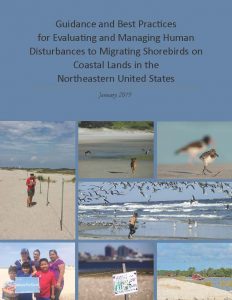Whether intentional or unintentional, human disturbance can have a significant negative impact on shorebirds and is recognized in shorebird conservation and recovery plans, as well as many published studies. The human disturbance threat is significant due to its potential demographic effect on shorebirds. Specifically, human disturbance reduces fitness expressed as lower reproductive rates and potentially as compromised ability to add weight due to exclusion from or interrupted access to food or resting locations. At extremes, human disturbance results in habitat that is unavailable to shorebirds.
Several projects and documents have been developed to help land managers address human disturbance issues related to beach walking and dogs.
Guidance and Best Practices
 Guidance and Best Practices for Evaluating and Managing Human Disturbances to Migrating Shorebirds on Coastal Lands in the Northeastern United States
Guidance and Best Practices for Evaluating and Managing Human Disturbances to Migrating Shorebirds on Coastal Lands in the Northeastern United States
Managers recognize human disturbance as a serious threat facing shorebirds throughout their annual cycle. Yet, most of the current research and management of human disturbance on shorebirds focuses on the breeding season. To address this gap, Virginia Tech and US Fish and Wildlife Service developed “Guidance and Best Practices for Addressing Human Disturbance to Shorebirds at Fall Migratory Stopover Sites” for the Northeastern U.S. Utilizing a transdisciplinary approach, integrating social, ecological, and stakeholder knowledge to create the document allowed for a more comprehensive set of guidelines, with the goal of wider utility for managers. Visit the Guidance and Best Practices webpage for the full suite of products.
 Guide to Applying Science and Management Insights and Human Behavior Change Strategies to Address Beach Walking and Dog Disturbance Along the Atlantic Flyway
Guide to Applying Science and Management Insights and Human Behavior Change Strategies to Address Beach Walking and Dog Disturbance Along the Atlantic Flyway
Virginia Tech and partners developed a guide in which insights from biological and social science fields are integrated, along with applied expertise and knowledge of land managers and conservation practitioners. It introduces shorebird conservation professionals and land managers to Community Based Social Marketing as an approach to changing human behavior to benefit shorebird conservation. View the entire guide and associated reports.
Pilot Projects Underway: Implementing Community Based Social Marketing Strategies
Virginia Tech and partners address the threat of disturbance to Red Knot, American Oystercatcher, Whimbrel, (and other shorebirds) by implementing Community Based Social Marketing strategies for human disturbance reduction, developing a shorebird disturbance reduction toolkit for land managers, and will disseminate the results throughout the Atlantic Flyway shorebird network.
The partners addressed this threat by applying strategies and lessons learned from Preventing Human Disturbance of Atlantic Flyway Shorebirds I and II, previously funded by NFWF, by implementing strategies to change human behavior through Community Based Social Marketing, by completing the promising pilot project underway in Georgia, by launching and monitoring new pilot projects (in NY, CT, SC, and NC), by creating a community of practice of professionals piloting the projects and disseminating the results throughout the Atlantic shorebird network. This work is essential to developing successful, scalable conservation strategies that can be applied along the Atlantic coast to positively change human behavior and improve shorebird survival and reproductive success. Check out the pilot projects from Phase III.
Human Disturbance Reduction Toolkit
Virginia Tech, Audubon, Manomet, and USFWS developed an online, accessible toolkit to highlight the best practices, case studies, and lessons learned from the transdisciplinary human disturbance project. The goal of the toolkit is to provide managers, practitioners, and conservation professionals with the resources, knowledge, and expertise to tackle human disturbance head-on through empirically tested social science methods. Discover more about community-based social marketing and behavior change strategies, tips for getting started, and downloadable resources, protocols, templates, graphics, and more to address human disturbance challenges at your site. Watch the toolkit webinar or jump in and explore the toolkit!
Other Tools and Resources
Share the Shore Website and Animated Videos available in English, Spanish, and Portuguese.

